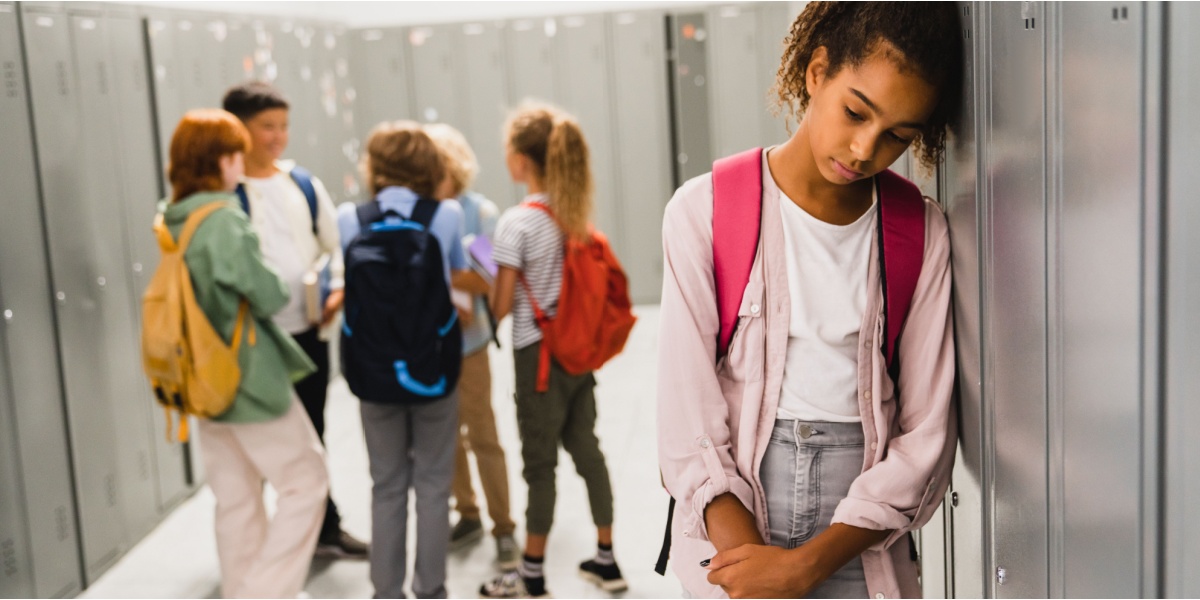Effective Ways to Deal with Bullying
It can be difficult to know how to deal with bullies when you, your child, or somebody else that you know is going through it. Anybody can be bullied, but they often feel too embarrassed, scared, or defeated to report it and seek help. That’s why it’s important to have all the information you need about bullying and its prevention to ensure victims feel heard and supported.

Bullying and Peer Abuse
Bullying is a very serious topic that affects many individuals of all ages, though it’s particularly common in schools. In fact, up to 75% of children will experience bullying and other abusive peer behaviors from as early as kindergarten. From name-calling to theft to physical attacks, bullying is always intended to hurt, marginalize and dominate victims.[1]
These victims often live with trauma for the rest of their lives, and it can influence how they form and maintain relationships with other people. Victims of repetitive bullying have a higher risk of developing mental health problems( including anxiety and depression), struggle to develop their social skills, have trouble fitting in, and are more likely to drop out of school. Some may even go on to become bullies themselves.[2]
The cycle of peer-on-peer abuse is fueled by the normalization of bullying in society. Too many people dismiss it as a “part of life” or something everybody has to go through in order to emotionally develop; however, this isn’t true. There is a lot of misinformation regarding bullying, which makes it harder to prevent it from happening.
Types of Bullying
There are several main types of bullying:
- Physical Bullying- aggressive physical behavior towards an individual by one or more persons, which includes kicking, hitting, scratching, spitting, pushing, and taking or breaking personal belongings.
- Verbal Bullying- spoken and written insults intended to hurt and upset an individual, including name-calling, making fun of someone’s appearance, and making cruel jokes.[3]
- Psychological Bullying- taunting and humiliating an individual to provoke a reaction and turn people against them, including spreading rumors, leaving them out, making them social pariahs, and tarnishing their reputations.[4]
- Cyberbullying- bullying that happens through devices, particularly on social media, through text messages, and on online forums, and includes sending cruel messages, sharing embarrassing photos, making threats, and impersonating the victim.[5]
- Sexual Bullying- sexual behavior towards an individual without their consent, including sending explicit messages, making lewd comments, spreading false rumors, making crude gestures, and physical harassment.[6]
- Prejudicial Bullying- insulting or attacking an individual based on factors relating to their personal identities, such as their race, gender, religion, ethnicity, or disability, by using slurs, marginalizing minority experiences, and isolating them from wider groups.[7]
Why Do People Bully?
When bullies abuse their peers, they attempt to achieve dominance over them in order to continue bullying and harassing them. It typically happens in a social context, such as within friendship groups or at schools, with the dominant party (the bully) enjoying the power and influence they have over their victim. As a result, the victim becomes more socially withdrawn, whereas the bully is likely to garner support from peers and bystanders who don’t want to take the side of the socially ostracized person and end up being bullied, too.
When an individual chooses to bully another, they are actively engaging in repetitive harassment and abuse. Nobody, especially young children, is born a bully, but people can be conditioned by those around them to develop and display abusive tendencies. For example, parents who regularly fight and shout at each other in front of their children model negative and abusive behaviors. Some bullies may even be victims of bullying by their parents or siblings, causing them to lash out at their peers in an attempt to gain some control.[8]
This idea of conditioning based on personal circumstances is what creates “bully-victims”: people who have experience on both sides. They are usually bullied by more dominant bullies but also exhibit bullying behaviors themselves, turning some of their other peers into victims. Bully-victims often display more mental health issues and a greater negativity towards school, friendships, and their own lives.[8]
The biggest problem with bullying is the lack of empathy displayed by bullies towards their peers. Even if they have been bullied themselves, they deliberately target people who are “weaker”, be it physically or socially, because it gives them that feeling of power. Victims who feel dominated by their bullies are less likely to report them or try to fight back, which means there are no repercussions.
The Impact of Bullying
Bullying can have lifelong impacts, even if it happens when a person is very young. The short-term effects of being bullied usually appear while the abuse is still happening and just after it has stopped. They include self-isolation, fear of going out, poor sleeping or eating habits, anxious thoughts, and emotional behaviors like crying.
However, the long-term impacts of being bullied can be far more insidious. Even after the bullying has stopped, the trauma it causes can impact the rest of a person’s life. It may result in many psychological symptoms, such as mental health problems like depression and anxiety and difficulty forming new social relationships.[9]
Interestingly, bullies also frequently experience negative long-term effects of bullying, even though they are the perpetrators, not the victims. Bullies and former bullies also often struggle with feelings of depression and have difficulty regulating their emotions and resolving conflict without lashing out. Their social adjustment in the period after the bullying may be poor, and they often turn to risky coping mechanisms.[9]
There are also bystanders to consider, who aren’t directly involved with the bullying but observe how one peer abuses another without intervening in any way. In both the short and long term, bystanders deal with feelings of guilt and regret, particularly if something bad happens to the victim. The bystander effect only fuels the cycle of abuse that allows bullies to victimize others.
How to Deal with Bullies
It’s difficult to know how to handle a bully if you fear the repercussions of taking action against them. In the early stages of bullying, the bully may be discouraged if you ignore what they say and continuously walk away from them, giving them no satisfaction. Bullying is often a play for attention or an attempt to look cool in front of others, so offering no reaction may cause them to lose interest.[10]
If you can see that a pattern of abuse is starting to form, you may be able to put a quick end to it by standing up to your bully and assertively confronting them. However, don’t do this if you are in a quiet or isolated place or if you feel physically threatened. Some bullies only target victims when they’re alone to avoid any consequences, so staying close to others can help deter them and provide support during any communication.
If it’s not possible or safe to try either of the above things, go straight to reporting the bully to someone you trust. Many people feel too hopeless or ashamed to admit that they’re being bullied, but this is the first step in how to deal with bullies. The more people involved in the situation, the less likely the bully is to continue, especially if it makes them aware of the consequences.
If you are not the target of bullying but suspect that your child, friend, or another person may be, it’s important to know what signs to look out for. These signs may include:
- Lost or broken possessions.
- Skipping school.
- Unexplained injuries.
- Poor self-esteem.
- Reduced socialization.
- Difficulty sleeping.[10]
Once you have confirmed that an individual is being bullied, you can attempt to guide them through the above steps to deal with the bully, ensuring the victim’s comfort and safety.
When to Seek Help
If bullying is repetitive and causes physical, emotional, and psychological trauma, it’s time to seek help. Many victims never speak up about what they’re going through because they’ve been squashed down, intimidated, and ostracized by one or more of their peers for a long time. They often don’t have the information they need on how to handle things.
Though it’s important to gather as much information as possible on how to deal with bullies and bullying prevention, this content shouldn’t restrict you from seeking help from other sources. There are plenty of resources available for children and adults alike to ask questions, receive support, and take action against bullying and peer abuse.
For mental health support and advice, you can get in contact with a crisis counselor by texting 741741, and they will listen to you and help you calm down. This is a great resource for those who need immediate help and have nobody to speak to. Young people aged between 13 and 24 can also access confidential counseling via the STOMP Out Bullying HelpChat Crisis Line.
Support groups, either in-person or online, are also a great way to seek help and guidance when dealing with bullying. The Mental Health America Affiliate Resource Center helps people find support groups in their areas. It’s also worth finding out whether your child’s school offers counseling and support services if they are being bullied by a peer.
There is nothing shameful about seeking help if you are being bullied. Bullying is characterized by its longevity, so bullies don’t usually quit their abusive behavior without somebody else intervening. Taking action against a bully, whether you are their target, a bystander, or a trusted third party, helps to end the victim’s abuse and aid bullying prevention.
- 7 Tips for Helping Your Child Deal with Bullying. (2023, September 26). Www.hopkinsmedicine.org. https://www.hopkinsmedicine.org/health/wellness-and-prevention/7-tips-for-helping-your-child-deal-with-bullying
- Addressing Childhood Bullying. (2023, August 29). NIH News in Health. https://newsinhealth.nih.gov/2023/09/addressing-childhood-bullying
- U.S. Department of Health and Human Services. (2024, October 7). What Is Bullying. StopBullying.gov; U.S. Department of Health and Human Services. https://www.stopbullying.gov/bullying/what-is-bullying
- Nwanosike, C. L., Ujoatuonu, I. V. N., Kanu, G. C., Ike, O. O., & Okeke, T. J. (2022). Social Bullying Among Undergraduates: The Roles of Internet Gaming Disorder, Risk-Taking Behavior, and Internet Addiction. Frontiers in Psychology, 13. https://www.frontiersin.org/journals/psychology/articles/10.3389/fpsyg.2022.830794/full
- StopBullying.gov. (2021, November 5). What Is Cyberbullying. Stopbullying.gov; U.S. Department of Health and Human Services. https://www.stopbullying.gov/cyberbullying/what-is-it
- Acas. (2021, March 15). Sexual harassment | Acas. Www.acas.org.uk. https://www.acas.org.uk/sexual-harassment
- Menesini, E., & Salmivalli, C. (2017). Bullying in schools: the state of knowledge and effective interventions. Psychology, Health & Medicine, 22(1), 240–253. https://www.tandfonline.com/doi/full/10.1080/13548506.2017.1279740
- Swearer, S. M., & Hymel, S. (2015). Understanding the psychology of bullying: Moving toward a social-ecological diathesis–stress model. American Psychologist, 70(4), 344–353. https://psycnet.apa.org/doiLanding?doi=10.1037%2Fa0038929
- Demanet, J., & Van Houtte, M. (2012). The Impact of Bullying and Victimization on Students’ Relationships. American Journal of Health Education, 43(2), 104–113. https://www.tandfonline.com/doi/abs/10.1080/19325037.2012.10599225
- How to Cope with Bullying | JED. (n.d.). The Jed Foundation. https://jedfoundation.org/resource/how-to-cope-with-bullying/
The Clinical Affairs Team at MentalHealth.com is a dedicated group of medical professionals with diverse and extensive clinical experience. They actively contribute to the development of content, products, and services, and meticulously review all medical material before publication to ensure accuracy and alignment with current research and conversations in mental health. For more information, please visit the Editorial Policy.
MentalHealth.com is a health technology company guiding people towards self-understanding and connection. The platform provides reliable resources, accessible services, and nurturing communities. Its purpose is to educate, support, and empower people in their pursuit of well-being.

Bridget Coila is a writer, specializing in topics related to childhood development, parenting, pregnancy, and grief.

Morgan Blair is a licensed therapist, writer and medical reviewer, holding a master’s degree in clinical mental health counseling from Northwestern University.
Further Reading
The Clinical Affairs Team at MentalHealth.com is a dedicated group of medical professionals with diverse and extensive clinical experience. They actively contribute to the development of content, products, and services, and meticulously review all medical material before publication to ensure accuracy and alignment with current research and conversations in mental health. For more information, please visit the Editorial Policy.
MentalHealth.com is a health technology company guiding people towards self-understanding and connection. The platform provides reliable resources, accessible services, and nurturing communities. Its purpose is to educate, support, and empower people in their pursuit of well-being.
